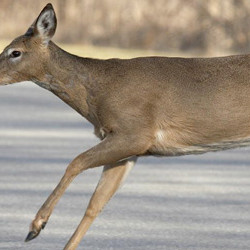Kentucky drivers entering peak season for deer collisions

When asked to identify the most dangerous animal in the United States, most people, depending on where they live, would likely point first to a bear, mountain lion, alligator or even a shark. While those are all seemingly logical choices, statistics from the Insurance Information Institute reveal that the deadliest animal roaming the country is actually the white-tailed deer.
According to the Insurance Information Institute’s estimates, each year white-tailed deer are responsible for tens of thousands of injuries and the deaths of approximately 150 Americans simply by causing car accidents. Those collisions also carry the hefty price tag of $4.6 billion annually in insurance claims. Locally, data from the Kentucky State Police (KSP) shows that the collisions also have seasonal peaks. Nearly 47% of all collisions with deer take place during the months of October, November and December.
“The primary reason why the number of deer collisions increases in the fall is that’s when deer are breeding,” explained Tina Brunjes, deer and elk program coordinator for the Kentucky Department of Fish and Wildlife Resources. “It’s on their mind to find other deer, not worry about where the cars are.”
Analysis by the Highway Loss Data Institute reveals that an average of 14.1 animal collisions per 1,000 drivers occurs nationally each November. Kentucky Farm Bureau (KFB) Insurance claims data, however, shows that drivers statewide nearly doubled the national average in November of 2010, hitting deer on roadways at a clip of 27.0 per 1,000 drivers. As a result of those collisions, KFB Insurance customers filed more than $3.6 million in claims during that month alone. For the entire year of 2010, Kentucky State Police data reports Kentuckians were in a total of 3,118 automobile collisions with deer, resulting in 169 injuries and four deaths.
“Looking at the numbers we can easily predict deer collision claims are going to rise dramatically in the fall and peak in November,” said Bill Reddington, KFB’s Director of Actuarial Services, “but we are also careful to remember that these are not just numbers. These are real people experiencing real accidents. We hope that by calling attention to this annual spike in deer strikes we can increase driver awareness and help prevent tragedy on Kentucky’s roads.”
As October is now here, Kentucky’s drivers are entering the peak three-month season for deer collisions. Motorists need to be aware of this hazard and recognize that they are twice as likely as usual to hit a deer on the road in the months of October and December. In November that probability climbs higher still as drivers in most Kentucky counties are three times as likely to collide with a deer on the road. Furthermore, there are 37 counties – most located in the western and northeastern parts of Kentucky – where drivers become four to seven times as likely to hit a deer during November’s peak season.
With the anticipated jump in activity from deer found on the roadways, motorists should drive slower and be aware of their surroundings even more than usual. Deer are most likely to be seen at dusk and dawn near tree-lined roadways or areas that transitions from open fields to forest or water, but drivers must remember that deer are wild animals and often exhibit unpredictable behaviors when on or near road.
“Deer, like any other creature, are going to look to cross the road where they feel safest,” added Brunjes. “If you see one run across the road in front of you, absolutely slow down because it’s very likely that there is another one behind it.”
Kentucky Farm Bureau advises motorists to drive defensively on the roadways this fall, especially when headed into wooded areas where deer are prevalent.
Tips to help drivers avoid deer collisions:
- Watch for deer crossing signs. These signs are posted to warn drivers that certain stretches of the road are commonly populated with deer. Do not ignore the warning.
- Be aware of the time. Deer are most commonly seen along roadways in the early morning and evening hours. Exercise additional caution if traveling during these times of day.
- When driving after dark, use high-beam headlights to increase the range of vision.
- If a deer is spotted on or near the road, slow down immediately.
- Don’t swerve if a deer is in the road. Brake firmly but keep the vehicle headed in a straight line. A swerving vehicle can confuse the animal and prevent it from picking a direction to flee, and, worse yet, the driver could lose control and hit a tree or another car.
- Always wear a seatbelt. The Kentucky State Police says that most people injured or killed in automobile collisions with deer are not wearing seat belts.
|
Click the map for larger view |
Click the map for larger view |
|
| This map highlights KFB Insurance’s “hot spots” by county for November deer collisions. | This map highlights KFB Insurance’s county-by-county odds of deer collisions in November. |
Designed by Kentucky Rural Water




